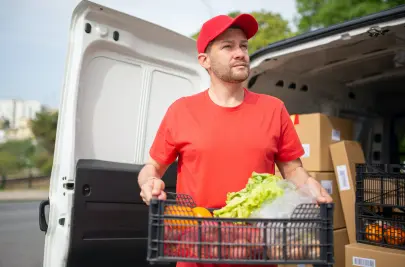
Companies who do last-mile deliveries have faced a series of challenges in the past few years:
- First, soaring demand for home delivery during pandemic lockdowns had small retailers scrambling to transform their businesses practically overnight.
- Then the Great Resignation sparked a shortage of drivers.
- Now, high gas prices are squeezing their margins – at the same time as consumers are cutting back their spending.
Ideas for how to cut your gas costs
1. Encourage driving habits that reduce fuel consumption
If there’s only one thing you do differently, make it this one. Why? Because better driving can save you up to 35% on gas costs!
The biggest improvement comes from simply driving more smoothly. Speeding, hard acceleration, and hard braking lower gas mileage by roughly 15% to 30% at highway speeds and 10% to 40% in stop-and-go traffic. Slowing down saves money, makes life a little less stressful for everyone else on the road, and is much safer.

If your city hasn’t already banned engine idling, this is another fuel-waster you can eliminate. Some people still think that keeping the engine running at traffic lights or during short stops is somehow more efficient or better for the engine, but nowadays we know that idling is just plain wasteful. Anytime a vehicle is going to be stopped for more than 10 seconds, it’s more efficient for the engine to be off.
Most modern vehicles now come equipped with driver feedback devices, which make it much easier to see how driving behavior affects fuel consumption. Keep an eye on the feedback device logs, and think about how you can incentivize your drivers – how about a monthly bonus for the most efficient driver? Stay realistic, though – as the video below notes, reducing speed by 5mph over 100 miles will add a couple of minutes to the journey time. If that means being able to serve one less stop, your planning will have to take that into account.
2. Lower gas costs by keeping your vehicles in top condition
Studies by the Department of Energy show that you can cut your gas costs by around 5% on average with some simple maintenance:
- Fixing an out-of-tune engine can save up to 4%.
- Replacing a faulty oxygen sensor can save a whopping 40% (these sensors monitor a vehicle’s exhaust gasses so the computer can accurately calculate how much fuel is needed for each combustion cycle).
- Keeping tires at the right pressure saves 1-2% on fuel costs, is safer and also helps them last longer.
- Using the manufacturer’s recommended motor oil can save another 1-2%.
You can read more about fleet maintenance for small delivery businesses here.
3. Choose the right vehicle for the job to lower delivery costs
Your vehicle choices might be increasing your gas and other costs for deliveries.
First, overloading a too-small vehicle will result directly in higher gas consumption, because every extra pound needs more energy to transport. Overloading may also make your tires run hotter, leading to under-inflation and, again, higher gas consumption. It will probably also increase wear and tear on your vehicle, which means higher maintenance costs.
On the other hand, having a vehicle that’s too big means you’re wasting gas carrying around unused space. It might also be difficult to park or drive down narrower streets, wasting time and creating pointless extra miles.
A vehicle is a big investment, so changing your fleet might not be so easy. But there are some things you can do:
- Ensure that your delivery routes are properly matching loads to vehicle capacities.
- Consider switching some deliveries to bicycles or e-bikes, which can have a range of up to 40 miles and capacity up to 65 gallons.
4. Optimize your routes to drive shorter distances and use less gas
Route optimization is using software to help plan the most efficient routes possible, given constraints like vehicle types and capacities, delivery times, and available routes.

On average, we estimate that route optimization can shorten delivery routes, and thus cut gas costs, by around 25%. In some cases we’ve seen gas costs cut by 30%.
5. Avoid high gas prices by delivering during low-traffic times
This one is not for every business, but could have a powerful impact on gas bills: consider delivering at night or during other times with low traffic. The World Economic Forum has estimated that night-time deliveries could cut last mile delivery costs by up to 28%! When there’s less traffic on the roads, you can get more deliveries done faster, potentially saving in wages as well as gas costs.
Organic juice delivery company Greenhouse Juice is a great example of a small business using a combination of route optimization and overnight delivery to get their product to their customers as fresh as possible, while also keeping their costs low.
I’ve done everything I can to cut my gas costs and they’re still hurting my business. Now what?
We hear you! Rising gas prices are especially tough on businesses that make deliveries. If you’ve tried all the ideas we’ve listed above for dealing with high gas prices directly, here are some more tactics to consider:
6. Be awesome to your drivers
Recruiting, onboarding and training new drivers is time-consuming and expensive, so hold onto the ones you’ve got! Good working conditions count for a lot when it comes to driver retention, so make sure your drivers are working decent hours, getting scheduled breaks, and that their routes are sensible, realistic, and fair.
7. Pass some of the costs on to your customers
Same-day or next-day delivery is convenient, but often not necessary. In fact, recent research suggests that consumers are willing to pay for greener delivery options, even if they take longer! You could save a lot of driving time and cash by batching all your deliveries to a certain area on the same day, for example, and giving customers a discount for waiting.
8. Offer a range of non-delivery options
There are plenty of ways to shop online that don’t require doorstep delivery. If you aren’t already doing so, consider offering in-store or curbside pickup, or delivery to a locker or self-service terminal.
The current high gas prices may come down again in the future, or they may stay high indefinitely. In either case, your business can benefit from becoming more fuel-efficient – and so will the planet. Good luck!
Frequently Asked Questions
Related articles
Liked this article? See below for more recommended reading!

Last Mile Delivery Costs — Challenges and Solutions

8 Practical Ways To Improve Delivery Efficiency



